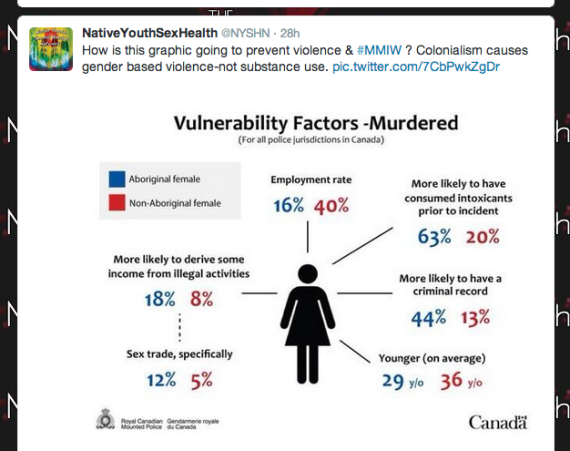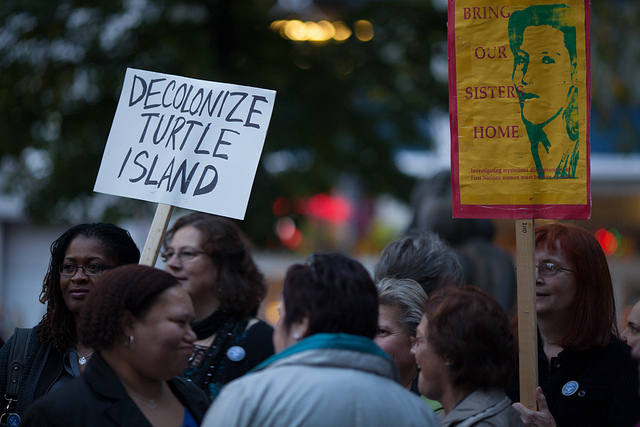On May 16, the RCMP released a 22-page “national operational overview” on missing and murdered Aboriginal women. The most valuable thing in the report are new statistics showing the total number of cases and how disproportionate they are to cases involving non-Aboriginal victims.
Previous to this report the estimate of total cases was based on data collected by the Native Women’s Association of Canada’s Sisters in Spirit Program. But when the federal government cut their funding in 2010, the number of confirmed cases was left at 582. Advocates knew the number by now was likely a lot higher, and the RCMP report confirms this. The distressing number of cases they have confirmed since 1980: 1,182.
Over 1,000 Indigenous women gone missing or found murdered. Aboriginal women make up 4.3 per cent of the female population, but 16 per cent of all female homicide victims, according to the report. It is unfathomable that that the same could have happened to 1,000 white women without urgent government and police action. But still, even knowing this number, the Harper Conservatives refuse to call a national public inquiry or take real steps to address the violence.
The Native Women’s Association of Canada released a brief statement saying they are pleased the report confirms what they have been saying for years and backs up their call for a national, coordinated effort to ending the violence.
The Native Youth Sexual Health Network (NYSHN) raised specific concerns with the focus of the report on the women’s seemingly individual “risk factors” (like alcohol/drug use and unemployment) rather than acknowledging any systemic issues like lack of access to safe transportation and the legacy of settler colonialism and racism.
Here’s one tweet NYSHN posted about a graphic from the RCMP report (I highly recommend following NYSHN on Twitter):

They also expressed their concern that the RCMP “is the system of colonialism” and that therefore they can’t embody the prevention effort needed. It’s worth noting the RCMP report does not address police violence against First Nations women; the only thing that really relates to their competency is their defence on the numbers of cases solved. On a related note, RCMP Commissioner Bob Paulson said the numbers of women “surprised him” but denied allegations of systemic bias in the RCMP contributed to it taking so long to put together this report
So while there is some important data in the report, it is hard not to feel frustrated with the limitations of the RCMP approach and the government response. And things only get more frustrating looking at the mainstream media coverage.
I saw the headline first on CBC:

“Aboriginal women more prone to violent death, RCMP say.” “Prone to violent death” makes it sounds like something that just happens. Like “redheads are more prone to sunburn” or “cats are prone to shed.”
Violent death is not something that just happens; it is perpetrated by other people. In this case, it is also facilitated by systemic and historical oppressions.
Read the first sentence of the article and the message to readers seems to be that, overall, this is something you don’t need to worry about:
An RCMP report says aboriginal women have been much more prone to violent death than non-natives, but police have solved cases involving both groups at almost the same rate.
I pulled up the report to take a close look, because the only reason I could see coming up with a saying like “prone to violent death” and crediting it to the RCMP is if they had actually used those words. As problematic as the report is, that phrase is never used. What the report says is: “they [Aboriginal women] are at higher risk of being victims of violence than non-Aboriginal females”. So yes, the focus in both cases is on the victims, but the media reports created their own language and made the violence seem more natural and inevitable.
I soon realized the CBC hadn’t originated the headline: it was the Canadian Press with this:
 For anyone who’s not familiar, the Canadian Press (CP) is a news agency (like the American Press or La Presse) jointly owned by other media companies, that publishes stories that are then syndicated and drawn on by media across Canada. That’s why if you searched “prone to violent death” on May 16 you’d find stories with the same or similar headlines on CTV, the National Post, Macleans, CityNews, the Huffington Post and many more media outlets. We saw a similar thing when the CP came up with the phrase “non-consensual sex” to euphemize chants at universities that glorified sexual assault; before you knew it, “non-consensual sex” was the term everyone was using.
For anyone who’s not familiar, the Canadian Press (CP) is a news agency (like the American Press or La Presse) jointly owned by other media companies, that publishes stories that are then syndicated and drawn on by media across Canada. That’s why if you searched “prone to violent death” on May 16 you’d find stories with the same or similar headlines on CTV, the National Post, Macleans, CityNews, the Huffington Post and many more media outlets. We saw a similar thing when the CP came up with the phrase “non-consensual sex” to euphemize chants at universities that glorified sexual assault; before you knew it, “non-consensual sex” was the term everyone was using.
Objectivity — not letting your biases interfere with your fair treatment of a story — is a foundation of journalistic ethics, enshrined in the Canadian Press’ and Canadian Association of Journalists’ (CAJ) ethics statements. While it’s debatable to what extent objectivity is ever possible, the language in the above headlines/stories is clearly not objective. It makes violence seem inevitable, due to the individual choices of women, and it positions the RCMP’s crime-solving ability as somehow mitigating the incredible tragedy and shame of the ongoing violence.
The CAJ statement also promises: “We make sure to retain the original context of all quotations or clips, striving to convey the original tone. Our reporting and editing will not change the meaning of a statement or exclude important qualifiers.” I would argue changing the language from what was used in the report violates this commitment.
I fired off some angry tweets at CBC, the National Post and the Canadian Press, and the CBC did slightly tweak the headline to read: “Aboriginal women more likely to suffer violent death.” I’ll call that a slight improvement.
I thank the outlets that I noticed that didn’t use the CP’s victim-blaming phrase: The Globe and Mail and Global News. Both of these stories focused more on the disproportionate number of cases and the need for further action, rather than helping explain away the violence.
Moving forward from this we need to be vigilant about the way the media reports this issue. For the violence to stop, we need more people to see how it’s systemic and affects all of us; not feel like this is something that was bad once, but the RCMP have a handle on it now, just because they say so.
Here are some tips and tools for writing letters to media and politicians on these issues.
Jarrah Hodge is the founder and editor of gender-focus.com. She has also written for the Huffington Post, Bitch Magazine Blogs and the Vancouver Observer. Jarrah has B.A. in Women’s Studies and Sociology from UBC. She serves on the City of Vancouver Women’s Advisory Committee and the Women, Action & the Media (WAM!) Vancouver core organizing group.
This post originally appeared on Gender-Focus and is reprinted with permission.




